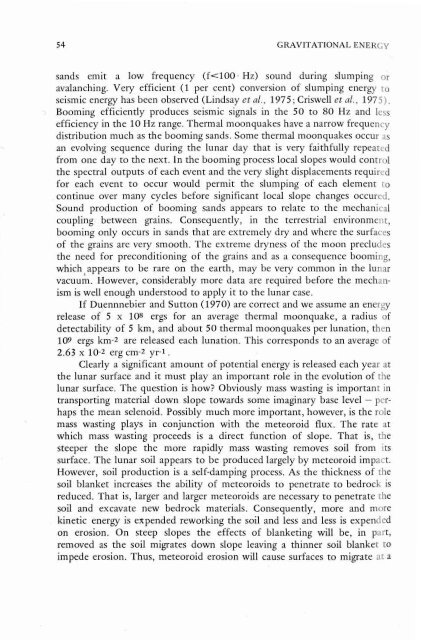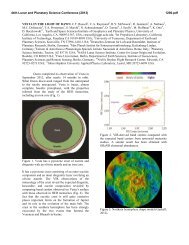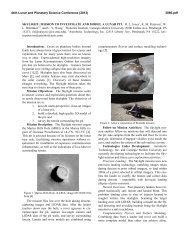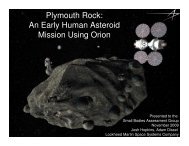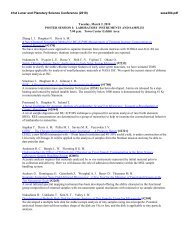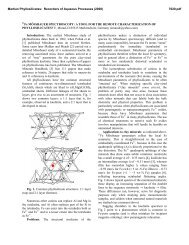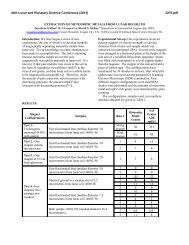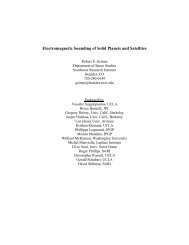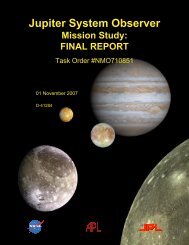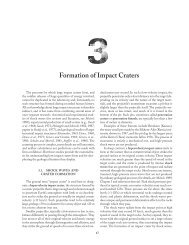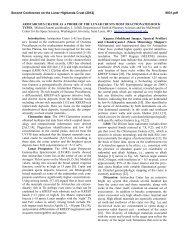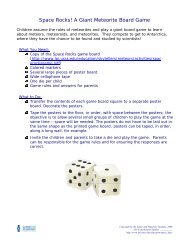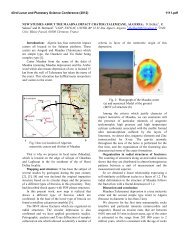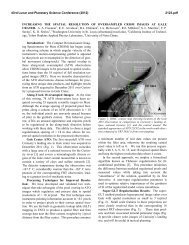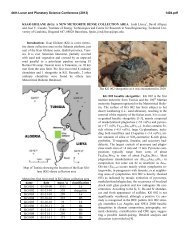Chapter 2: Energy at the Lunar Surface - Lunar and Planetary Institute
Chapter 2: Energy at the Lunar Surface - Lunar and Planetary Institute
Chapter 2: Energy at the Lunar Surface - Lunar and Planetary Institute
You also want an ePaper? Increase the reach of your titles
YUMPU automatically turns print PDFs into web optimized ePapers that Google loves.
I<br />
I<br />
54 GRAVITATIONAL ENERGY<br />
s<strong>and</strong>s emit a low frequency (f-=100. Hz) sound during slumping or<br />
avalanching. Very efficient (1 per cent) conversion of slumping energy to<br />
seismic energy has been observed (Lindsay et al., 197 5 ; Criswell et al., 197 5).<br />
Booming efficiently produces seismic signals in <strong>the</strong> 50 to 80 Hz <strong>and</strong> less<br />
efficiency in <strong>the</strong> 10 Hz range. Thermal moonquakes have a narrow frequency<br />
distribution much as <strong>the</strong> booming s<strong>and</strong>s. Some <strong>the</strong>rmal moonquakes occur as<br />
an evolving sequence during <strong>the</strong> lunar day th<strong>at</strong> is very faithfully repe<strong>at</strong>ed<br />
from one day to <strong>the</strong> next. In <strong>the</strong> booming process local slopes would control<br />
<strong>the</strong> spectral outputs of each event <strong>and</strong> <strong>the</strong> very slight displacements required<br />
for each event to occur would permit <strong>the</strong> slumping of each element to<br />
continue over many cycles before significant local slope changes occured.<br />
Sound production of booming s<strong>and</strong>s appears to rel<strong>at</strong>e to <strong>the</strong> mechanical<br />
coupling between grains. Consequently, in <strong>the</strong> terrestrial environment,<br />
booming only occurs in s<strong>and</strong>s th<strong>at</strong> are extremely dry <strong>and</strong> where <strong>the</strong> surfaces<br />
of <strong>the</strong> grains are very smooth. The extreme dryness of <strong>the</strong> moon precludes<br />
<strong>the</strong> need for preconditioning of <strong>the</strong> grains <strong>and</strong> as a consequence booming,<br />
whichcappears to be rare on <strong>the</strong> earth, may be very common in <strong>the</strong> lunar<br />
vacuum. However, considerably more d<strong>at</strong>a are required before <strong>the</strong> mechan-<br />
ism is well enough understood to apply it to <strong>the</strong> lunar case.<br />
If Duennnebier <strong>and</strong> Sutton (1970) are correct <strong>and</strong> we assume an energy<br />
release of 5 x 108 ergs for an average <strong>the</strong>rmal moonquake, a radius of<br />
detectability of 5 km, <strong>and</strong> about 50 <strong>the</strong>rmal moonquakes per lun<strong>at</strong>ion, <strong>the</strong>n<br />
109 ergs km-2 are released each lun<strong>at</strong>ion. This corresponds to an average of<br />
2.63 x 10-2 erg cm-2 yr-1 .<br />
Clearly a significant amount of potential energy is released each year <strong>at</strong><br />
<strong>the</strong> lunar surface <strong>and</strong> it must play an important role in <strong>the</strong> evolution of <strong>the</strong><br />
lunar surface. The question is how? Obviously mass wasting is important in<br />
transporting m<strong>at</strong>erial down slope towards some imaginary base level - per-<br />
haps <strong>the</strong> mean selenoid. Possibly much more important, however, is <strong>the</strong> role<br />
mass wasting plays in conjunction with <strong>the</strong> meteoroid flux. The r<strong>at</strong>e <strong>at</strong><br />
which mass wasting proceeds is a direct function of slope. Th<strong>at</strong> is, <strong>the</strong><br />
steeper <strong>the</strong> slope <strong>the</strong> more rapidly mass wasting removes soil from its<br />
surface. The lunar soil appears to be produced largely by meteoroid impact.<br />
However, soil production is a self-damping process. As <strong>the</strong> thickness of <strong>the</strong><br />
soil blanket increases <strong>the</strong> ability of meteoroids to penetr<strong>at</strong>e to bedrock is<br />
reduced. Th<strong>at</strong> is, larger <strong>and</strong> larger meteoroids are necessary to penetr<strong>at</strong>e <strong>the</strong><br />
soil <strong>and</strong> excav<strong>at</strong>e new bedrock m<strong>at</strong>erials. Consequently, more <strong>and</strong> more<br />
kinetic energy is expended reworking <strong>the</strong> soil <strong>and</strong> less <strong>and</strong> less is expended<br />
on erosion. On steep slopes <strong>the</strong> effects of blanketing will be, in part,<br />
removed as <strong>the</strong> soil migr<strong>at</strong>es down slope leaving a thinner soil blanket to<br />
impede erosion. Thus, meteoroid erosion will cause surfaces to migr<strong>at</strong>e <strong>at</strong> a


